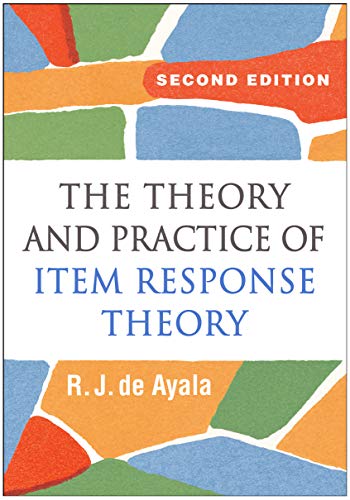

Most ebook files are in PDF format, so you can easily read them using various software such as Foxit Reader or directly on the Google Chrome browser.
Some ebook files are released by publishers in other formats such as .awz, .mobi, .epub, .fb2, etc. You may need to install specific software to read these formats on mobile/PC, such as Calibre.
Please read the tutorial at this link. https://ebooknice.com/page/post?id=faq
We offer FREE conversion to the popular formats you request; however, this may take some time. Therefore, right after payment, please email us, and we will try to provide the service as quickly as possible.
For some exceptional file formats or broken links (if any), please refrain from opening any disputes. Instead, email us first, and we will try to assist within a maximum of 6 hours.
EbookNice Team

Status:
Available4.3
19 reviews
ISBN 10: 1462547753
ISBN 13: 9781462547753
Author: R J de Ayala
Noted for addressing both the "hows" and "whys" of item response theory (IRT), this text has been revised and updated with the latest techniques (multilevel models, mixed models, and more) and software packages. Simple to more complex models are covered in consistently formatted chapters that build sequentially. The book takes the reader from model development through the fit analysis and interpretation phases that would be performed in practice. To facilitate understanding, common data sets are used across chapters, with the examples worked through for increasingly complex models. Exemplary model applications include free (BIGSTEPS, NOHARM, Facets, R packages) and commercial (BILOG-MG, flexMIRT, SAS, WINMIRA, SPSS, SYSTAT) software packages. The companion website provides data files and online-only appendices. New to This Edition *Chapter on multilevel models. *New material on loglinear models, mixed models, the linear logistic trait model, and fit statistics. *Many additional worked-through examples. *Updated guidance on software; now includes R, SAS, and flexMIRT.
1. Introduction to Measurement
Measurement
Some Measurement Issues
Item Response Theory
Classical Test Theory
Latent Class Analysis
Summary
2. The One-Parameter Model
Conceptual Development of the Rasch Model
The One-Parameter Model
The One-Parameter Logistic Model and the Rasch Model
Assumptions Underlying the Model
An Empirical Data Set: The Mathematics Data Set
3. Joint Maximum Likelihood Parameter Estimation
Joint Maximum Likelihood Estimation
Indeterminacy of Parameter Estimates
How Large a Calibration Sample?
Example: Application of the Rasch Model to the Mathematics Data, JMLE, BIGSTEPS
Example: Application of the Rasch Model to the Mathematics Data, JMLE, mixRasch
Validity Evidence
Summary of the Application of the Rasch Model
Summary
4. Marginal Maximum Likelihood Parameter Estimation
Marginal Maximum Likelihood Estimation
Estimating an Individual’s Location: Expected A Posteriori
Example: Application of the Rasch Model to the Mathematics Data, MMLE, BILOG-MG
Metric Transformation and the Total Characteristic Function
Example: Application of the Rasch Model to the Mathematics Data, MMLE, mirt
Summary
5. The Two-Parameter Model
Conceptual Development of the Two-Parameter Model
Information for the Two-Parameter Model
Conceptual Parameter Estimation for the 2PL Model
How Large a Calibration Sample?
6. The Three-Parameter Model
Conceptual Development of the Three-Parameter Model
Additional Comments about the Pseudo-Guessing Parameter, Xj
Conceptual Parameter Estimation for the 3PL Model
How Large a Calibration Sample?
Assessing Conditional Independence
Example: Application of the 3PL Model to the Mathematics Data, MMLE, BILOG-MG
7. Rasch Models for Ordered Polytomous Data
Conceptual Development of the Partial Credit Model
Conceptual Parameter Estimation of the PC Model
Example: Application of the PC Model to a Reasoning Ability Instrument, MMLE, flexMIRT
Example: Application of the PC Model to a Reasoning Ability Instrument, MMLE, mirt
The Rating Scale Model
8. Non-Rasch Models for Ordered Polytomous Data
The Generalized Partial Credit Model
Example: Application of the GPC Model to a Reasoning Ability Instrument, MMLE, flexMIRT
Example: Application of the GPC Model to a Reasoning Ability Instrument, MMLE, mirt
Conceptual Development of the Graded Response Model
How Large a Calibration Sample?
9. Models for Nominal Polytomous Data
Conceptual Development of the Nominal Response Model
Information for the NR Model
Metric Transformation, NR Model
Conceptual Development of the Multiple-Choice Model
How Large a Calibration Sample?
Example: Application of the NR Model to a General Science Test, MMLE, mirt
Summary
10. Models for Multidimensional Data
Conceptual Development of a Multidimensional IRT Model
Multidimensional Item Location and Discrimination
Item Vectors and Vector Graphs
The Multidimensional Three-Parameter Logistic Model
11. Linking and Equating
Equating Defined
Equating: Data Collection Phase
Equating: Transformation Phase
12. Differential Item Functioning
Differential Item Functioning and Item Bias
Mantel–Haenszel Chi-Square
The TSW Likelihood Ratio Test
Logistic Regression
13. Multilevel IRT Models
Multilevel IRT—Two Levels
Example: Estimating the Rasch Model from a Multilevel Perspective, proc glimmix
Example: Rasch Model Estimation, lme4
Person-Level Predictors for Items
Example: Person-Level Predictors for Items—DIF Analysis, proc glimmix
the theory and practice of item response theory
the theory and practice of item response theory second edition
the theory and practice of item response theory de ayala
the theory and practice of item response theory pdf
the basics of item response theory using r pdf
theory ebook
Tags: R J de Ayala, Theory, Practice